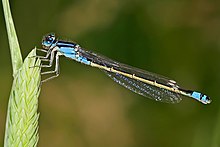Damselfly
Damselflies are insects in the order Odonata.[1] They are similar to dragonflies, but are in a separate suborder, the Zygoptera. There are 20 families of damselfly. "Demoiselle" is another name for damselflies.
| Damselflies Temporal range: 271–0 mya
| |
|---|---|

| |
| Male common bluetail damselfly | |
| Scientific classification | |
| Kingdom: | |
| Phylum: | |
| Class: | |
| Order: | |
| Suborder: | Zygoptera Selys, 1854
|

The wings of most damselflies are held along, and parallel to, the body when at rest. There are also damselfly families in which the wings are held open, as in the true dragonflies (Anisoptera).
Damselflies are also usually smaller, weaker fliers than dragonflies. Their eyes are well separated by more than their own diameter. Another distinction is that their forewings and hindwings look similar; this is not the case in the true dragonflies. Like dragonflies, damselflies cannot walk, but only land. Their life cycle is also similar. They have incomplete metamorphosis, with an aquatic nymph. The nymph is carnivorous, as is the adult.
Damselflies have existed since the later Carboniferous (early forms may be put in the Protozygoptera by some authorities).[2] They are found on every continent except Antarctica. One feature of their life is different from dragonflies. Not only do their nymphs grow in rivers, but the adults usually keep close to the river, and live in colourful little groups. Most damselflies live their lives within a short distance of where they were hatched.
They are often brilliantly coloured, but when they land on a bush, out of direct sunlight, they are not easy to see. They land and close their wings at the same instant. They have eyes which detect movement well, and they fly off if anything moves nearby. Thus, although they are fragile and highly coloured, they are not easily caught by predators.[3]
All damselflies are predatory; both nymphs and adults eat other insects.
References
change- ↑ Berger, Cynthia (2004). Dragonflies. Stackpole Books. ISBN 978-0-8117-2971-0.
- ↑ Jarzembowski E.A. & Nel A. 2002. The earliest damselfly-like insect and the origin of modern dragonflies (Insecta: Odonaptera: Protozygoptera). Proceedings of the Geological Association 111, 2, 165-169.
- ↑ Dijkstra, Klaas-Douwe B. 2006. Field Guide to the dragonflies of Britain and Europe. British Wildlife Publishing. ISBN 978-0-9531399-4-1